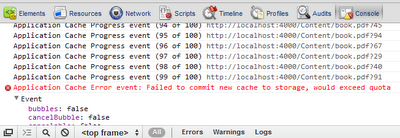Friday, March 30. 2012
Fake ID holders beware: facial recognition service Face.com can now detect your age
Via VB
-----
Facial-recognition platform Face.com could foil the plans of all those under-age kids looking to score some booze. Fake IDs might not fool anyone for much longer, because Face.com claims its new application programming interface (API) can be used to detect a person’s age by scanning a photo.
With its facial recognition system, Face.com has built two Facebook apps that can scan photos and tag them for you. The company also offers an API for developers to use its facial recognition technology in the apps they build.
Its latest update to the API can scan a photo and supposedly determine a person’s minimum age, maximum age, and estimated age. It might not be spot-on accurate, but it could get close enough to determine your age group.
“Instead of trying to define what makes a person young or old, we provide our algorithms with a ton of data and the system can reverse engineer what makes someone young or old,” Face.com chief executive Gil Hirsch told VentureBeat in an interview. ”We use the general structure of a face to determine age. As humans, our features are either heighten or soften depending on the age. Kids have round, soft faces and as we age, we have elongated faces.”
The algorithms also take wrinkles, facial smoothness, and other telling age signs into account to place each scanned face into a general age group. The accuracy, Hirsch told me, is determined by how old a person looks, not necessarily how old they actually are. The API also provides a confidence level on how well it could determine the age, based on image quality and how the person looks in photo, i.e. if they are turned to one side or are making a strange face.
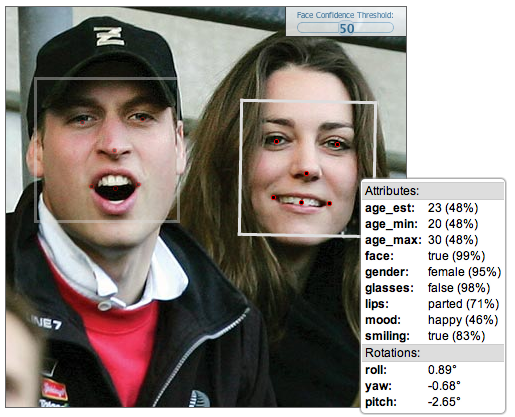
“Adults are much harder to figure out [their age], especially celebrities. On average, humans are much better at detecting ages than machines,” said Hirsch.
The hope is to build the technology into apps that restrict or tailor content based on age. For example the API could be built into a Netflix app, scan a child’s face when they open the app, determine they’re too young to watch The Hangover, and block it. Or — and this is where the tech could get futuristic and creepy — a display with a camera could scan someone’s face when they walk into a store and deliver ads based on their age.
In addition to the age-detection feature, Face.com says it has updated its API with 30 percent better facial recognition accuracy and new recognition algorithms. The updates were announced Thursday and the API is available for any developer to use.
One developer has already used the API to build app called Age Meter, which is available in the Apple App Store. On its iTunes page, the entertainment-purposes-only app shows pictures of Justin Bieber and Barack Obama with approximate ages above their photos.
Other companies in this space include Cognitec, with its FaceVACS software development kit, and Bayometric, which offers FaceIt Face Recognition. Google has also developed facial-recognition technology for Android 4.0 and Apple applied for a facial recognition patent last year.
The technology behind scanning someone’s picture, or even their face, to figure out their age still needs to be developed for complete accuracy. But, the day when bouncers and liquor store cashiers can use an app to scan a fake ID’s holder’s face, determine that they are younger than the legal drinking age, and refuse to sell them wine coolers may not be too far off.
EU Votes To Lower Mobile Roaming Charges
Via CIO TODAY
-----
Business travelers -- and the enterprises that foot their phone bills -- have been complaining about high roaming fees in Europe for years. Now, some relief is finally in sight.
Indeed, both data roaming and phone calls travelers make while doing business (or taking a vacation) in Europe should be much cheaper this summer thanks to a deal done in the European Parliament this week.
Members of the European Parliament and the Danish Presidency of the Council of Ministers agreed to lower price caps on roaming. Parliament as a whole still needs to approve the deal. But if all runs smoothly the new rules will take effect July 1.
"I am satisfied that the Council approved Parliament's approach to tackle very high prices of phone calls, SMS and in particular of data roaming," said Angelika Niebler of Germany, Parliament's reporter for the draft legislation. "The proposed price caps ensure a sufficient margin between wholesale and retail prices to assure a level of competition that will enable new players to enter the market."
How Low Do They Go?
The agreement increases transparency and consumer protection to prevent bill shocks, Niebler said. That means European Union consumers no longer need to worry about accidentally running up huge bills when using their mobile devices both within and outside the EU. Of course, it's also a boon for consumers from other nations traveling to Europe.
How much savings are we talking about? According to the new rules, a downloaded megabyte would cost no more than 70 cents. That cost drops down to 45 cents in 2013 and 20 cents by July 2014. This is a big improvement, seeing as there is currently no price ceiling for mobile data services charged to consumers.
On the phone call front, the cost of a one-minute call would not exceed 29 cents under the new rules. That declines to 19 cents as of July 2014. That's down from 35 cents under the current legislation. Finally, an SMS would cost no more than 9 cents. That drops to 6 cents as by July 2014 and marks an 11 percent cut from current costs.
Nixing Roaming Altogether
"Mobile roaming charges in the EU are artificially high. Given the fact that they are trying to treat the entire continent like a single country, I don't understand why mobile roaming charges are so high between countries," said Mike Disabato, managing vice president of network and telecom at Gartner.
Practically speaking, the new rules mean that you only need one SIM card while traveling in Europe. Of course, you can't get a SIM card on an iPhone unless you buy an unlocked phone for $800. But if you do use a SIM card you will not have to change phone numbers every time you go to a different country.
"The new rules will make it a lot cheaper for people who actually have to do business in Europe. Any time you start reducing these types of rates it's a good thing," Disabato said. "We got rid of roaming charges a long time ago. It's about time they go in Europe. It will take until the EU decides they are going to make it happen."TRON... in 219 bytes
Via Christian Babski
-----

You can have an explanation from the authors of this short piece of code.
Or just play it (i, j, k or l to start)
How a web application can download and store over 2GB without you even knowing it
Via Jef Claes
-----
I have been experimenting with the HTML5 offline application cache some more over the last few days, doing boundary tests in an attempt to learn more about browser behaviour in edge cases.
One of these experiments was testing the cache quota.
Two weeks ago, I blogged about generating and serving an offline application manifest using ASP.NET MVC. I reused that code to add hundreds of 7MB PDF files to the cache.
public ActionResult Manifest() { var cacheResources = new List<string>(); var n = 300; // Play with this number for (var i = 0; i < n; i++) cacheResources.Add("Content/" + Url.Content("book.pdf?" + i)); var manifestResult = new ManifestResult("1") { NetworkResources = new string[] { "*" }, CacheResources = cacheResources }; return manifestResult; }I initially tried adding 1000 PDF files to the cache, but this threw an error: Chrome failed to commit the new cache to the storage, because the quota would be exceeded.
After lowering the number of files several times, I hit the sweet spot. I could add 300 PDF files to the cache without breaking it.
Something else I noticed, is that other sites now fail to commit anything to the application cache due to the browser-wide quota being exceeded. I'm pretty sure this 'first browsed, first reserved' approach will be a source of frustration in the future.
To handle this scenario we could use the applicationCache API to listen for quota errors, and inform the user to browse to chrome://appcache-internals/ and remove other caches in favor of the new one. This feels sketchy though; shouldn't the browser intervene in a more elegant way here?
Thursday, March 29. 2012
LG flexible epaper devices promised for April launch
Via Slash Gear
-----
LG Display has launched a new, 6-inch flexible epaper display that the company expects to show up in bendable products by the beginning of next month. The panel, a 1024 x 768 monochrome sheet, can be bent up to 40-degrees without breaking; in addition, because LG Display has used a flexible plastic substrate rather than the more traditional glass, it’s less than half the weight of a traditional epaper panel.
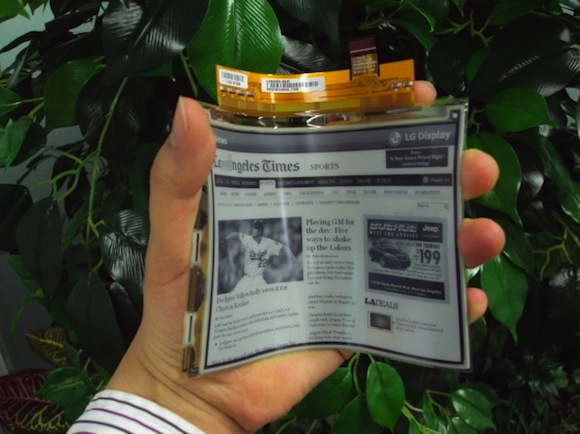
That means lighter gadgets that are actually more durable since the panels should be more resilient to drops or bumps. They can also be thinner, too: the plastic panel is a third slimmer than glass equivalents, at just 0.7mm thick.
LG Display says it can drop its new screen from 1.5m – the average height a device is held when it’s being used for reading, apparently – without any resulting damage. The company also hit the screen with a plastic hammer, leaving no scratches or breaks, ETNews reports.
LG isn’t the only company to be working on flexible screens this year. Samsung has already confirmed that it is looking at launching devices using flexible AMOLED panels in 2012, though it’s unclear whether the screens will actually fold or bend, or simply be used to wrap around smartphones for new types of UI.
The first products using the LG Display flexible panel are on track for a release in the European market in early April, the company claims. No word on what vendors will be offering them, nor how pricing will compare to traditional glass-substrate epaper.
Wednesday, March 28. 2012
Anatomy of a leak: how iPhones spill the ID of networks they access
Via ars technica
-----
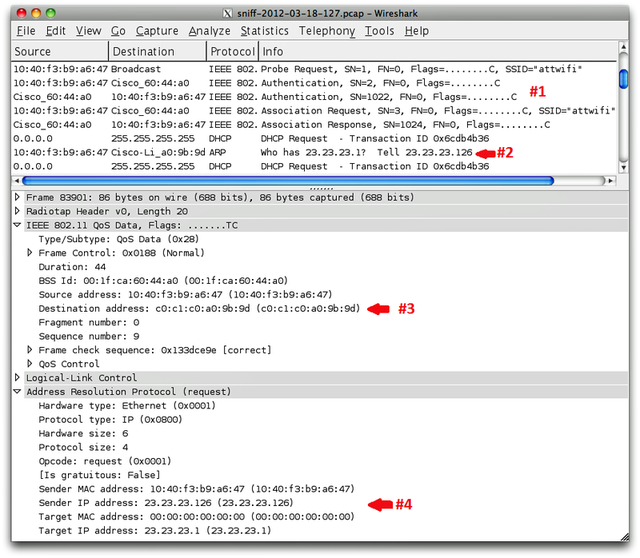
An Ars story from earlier this month reported that iPhones expose the unique identifiers of recently accessed wireless routers, which generated no shortage of reader outrage. What possible justification does Apple have for building this leakage capability into its entire line of wireless products when smartphones, laptops, and tablets from competitors don't? And how is it that Google, Wigle.net, and others get away with publishing the MAC addresses of millions of wireless access devices and their precise geographic location?
Some readers wanted more technical detail about the exposure, which applies to three access points the devices have most recently connected to. Some went as far as to challenge the validity of security researcher Mark Wuergler's findings. "Until I see the code running or at least a youtube I don't believe this guy has the goods," one Ars commenter wrote.
According to penetration tester Robert Graham, the findings are legit.
In the service of our readers, and to demonstrate to skeptics that the privacy leak is real, Ars approached Graham and asked him to review the article for accuracy and independently confirm or debunk Wuergler's findings.
"I can confirm all the technical details of this 'hack,'" Graham, who is CEO of Errata Security, told Ars via e-mail. "Apple products do indeed send out three packets that will reveal your home router MAC address. I confirmed this with my latest iPad 3."
He provided the image at the top of this post as proof. It shows a screen from Wireshark, a popular packet-sniffing program, as his iPad connected to a public hotspot at a Starbucks in Atlanta. Milliseconds after it connected to an SSID named "attwifi" (as shown in the section labeled #1), the iPad broadcasted the MAC address of his Linksys home router (shown in the section labeled #2). In section #3, the iPad sent the MAC address of this router a second time, and curiously, the identifier was routed to this access point even though it's not available on the local network. As is clear in section #4, the iPad also exposed the local IP address the iPad used when accessing Graham's home router. All of this information is relatively simple to view by anyone within radio range.
The image is consistent with one provided by Wuergler below. Just as Wuergler first claimed, it shows an iPhone disclosing the last three access points it has connected to.

Graham used Wireshark to monitor the same Starbucks hotspot when he connected with his Windows 7 laptop and Android-based Kindle Fire. Neither device exposed any previously connected MAC addresses. He also reviewed hundreds of other non-Apple devices as they connected to the network, and none of them exposed previously accessed addresses, either.
As the data makes clear, the MAC addresses were exposed in ARP (address resolution protocol) packets immediately after Graham's iPad associated with the access point but prior to it receiving an IP address from the router's DHCP server. Both Graham and Wuergler speculate that Apple engineers intentionally built this behavior into their products as a way of speeding up the process of reconnecting to access points, particularly those in corporate environments. Rather than waiting for a DHCP server to issue an IP address, the exposure of the MAC addresses allows the devices to use the same address it was assigned last time.
"This whole thing is related to DHCP and autoconfiguration (for speed and less traffic on the wire)," Wuergler told Ars. "The Apple devices want to determine if they are on a network that they have previously connected to and they send unicast ARPs out on the network in order to do this."
Indeed, strikingly similar behavior was described in RFC 4436, a 2006 technical memo co-written by developers from Apple, Microsoft, and Sun Microsystems. It discusses a method for detecting network attachment in IPv4-based systems.
"In this case, the host may determine whether it has re-attached to the logical link where this address is valid for use, by sending a unicast ARP Request packet to a router previously known for that link (or, in the case of a link with more than one router, by sending one or more unicast ARP Request packets to one or more of those routers)," the document states at one point. "The ARP Request MUST use the host MAC address as the source, and the test node MAC address as the destination," it says elsewhere.
Of course, only Apple engineers can say for sure if the MAC disclosure is intentional, and representatives with the company have declined to discuss the issue with Ars. What's more, if RFC 4436 is the reason for the behavior, it's unclear why there's no evidence of Windows and Android devices doing the same thing. If detecting previously connected networks is such a good idea, wouldn't Microsoft and Google want to design their devices to do it, too?
In contrast to the findings of Graham and Wuergler were those of Ars writer Peter Bright, who observed different behavior when his iPod touch connected to a wireless network. While the Apple device did expose a MAC address, the unique identifier belonged to the Ethernet interface of his router rather than the MAC address of the router's WiFi interface, which is the identifier cataloged by Google, Skyhook, and similar databases.
Bright speculated that many corporate networks likely behave the same way. And for Apple devices that connect to access points with such configurations, exposure of the MAC address may pose less of a threat. Still, while it's unclear what percentage of wireless routers assign a different MAC address to wired and wireless interfaces, Graham and Wuergler's tests show that at least some wireless routers by default make no such distinction.
Wuergler also debunked a few other misconceptions that some people had about the wireless behavior of Apple devices. Specifically, he said claims that iPhones don't broadcast the SSID they are looking for from Errata Security's Graham are incorrect. Some Ars readers had invoked the 2010 blog post from Graham to cast doubt on Wuergler's findings
"The truth is Apple products do probe for known SSIDs (and no, there is no limit as to how many)," Wuergler wrote in a post published on Friday to the Daily Dave mailing list. He included the following screenshot to document his claim.

Connecting the dots
What all of this means is that there's good reason to believe that iPhones and other Apple products—at least when compared to devices running Windows or Android—are unique in leaking MAC addresses that can uniquely identify the locations of networks you've connected to recently. When combined with other data often exposed by virtually all wireless devices—specifically the names of wireless networks you've connected to in the past—an attacker in close proximity of you can harvest this information and use it in targeted attacks.
Over the past year or so, Google and Skyhook have taken steps to make it harder for snoops to abuse the GPS information stored in their databases. Google Location Services, for instance, now requires the submission of two MAC addresses in close proximity of each other before it will divulge where they are located. In many cases, this requirement can be satisfied simply by providing one of the other MAC addresses returned by the Apple device. If it's within a few blocks of the first one, Google will readily provide the data. It's also feasible for attackers to use war dialing techniques to map the MAC addresses of wireless devices in a given neighborhood or city.
Since Apple engineers are remaining mum, we can only guess why iDevices behave the way they do. What isn't in dispute is that, unlike hundreds of competing devices that Wuergler and Graham have examined, the Apple products leak connection details many users would prefer to keep private.
A video demonstrating the iPhone's vulnerability to fake access point attacks is here.
Updated to better describe video.Image courtesy of Robert Graham, Errata Security
Tuesday, March 27. 2012
TI Demos OMAP5 WiFi Display Mirroring on Development Platform
Via AnandTech
-----
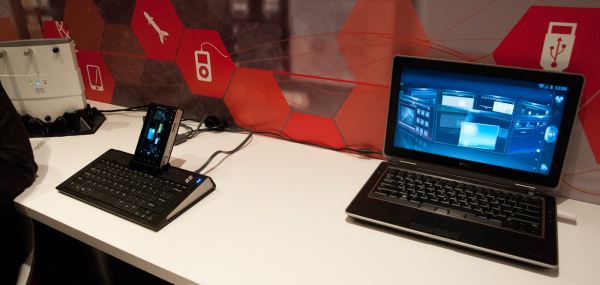
On our last day at MWC 2012, TI pulled me aside for a private demonstration of WiFi Display functionality they had only just recently finalized working on their OMAP 5 development platform. The demo showed WiFi Display mirroring working between the development device’s 720p display and an adjacent notebook which was being used as the WiFi Display sink.
TI emphasized that what’s different about their WiFi Display implementation is that it works using the display framebuffer natively and not a memory copy which would introduce delay and take up space. In addition, the encoder being used is the IVA-HD accelerator doing the WiFi Display specification’s mandatory H.264 baseline Level 3.1 encode, not a software encoder running on the application processor. The demo was running mirroring the development tablet’s 720p display, but TI says they could easily do 1080p as well, but would require a 1080p framebuffer to snoop on the host device. Latency between the development platform and display sink was just 15ms - essentially one frame at 60 Hz.
The demonstration worked live over the air at TI’s MWC booth and also used a WiLink 8 series WLAN combo chip. There was some stuttering, however this is understandable given the fact that this demo was using TCP (live implementations will use UDP) and of course just how crowded 2.4 and 5 GHz spectrum is at these conferences. In addition, TI collaborated with Screenovate for their application development and WiFi Display optimization secret sauce, which I’m guessing has to do with adaptive bitrate or possibly more.
Enabling higher than 480p software encoded WiFi Display is just one more obvious piece of the puzzle which will eventually enable smartphones and tablets to obviate standalone streaming devices.
-----
Personal Comment:
Kind of obvious and interesting step forward as it is more and more requested by mobile devices users to be able to beam or 'to TV' mobile device's screens... which should lead to transform any (mobile) device in a full-duplex video broadcasting enabled device (user interaction included!) ... and one may then succeed in getting rid of some cables in the same sitting?!
Monday, March 26. 2012
New Samsung sensor captures image, depth simultaneously
Via electronista
-----
Samsung has developed a new camera sensor technology that offers the ability to simultaneously capture image and depth. The breakthrough could potentially be applied to smartphones and other devices as an alternative method of control where hand gestures could be used to carry out functions without having to touch a screen or other input. According to Tech-On, it uses a CMOS sensor with red, blue and green pixels, combined with an additional z-pixel for capturing depth.
The
new Samsung sensor can capture images at a resolution of 1,920x720
using its traditional RGB array, while it can also capture a depth image
at a resolution of 480x360 with the z-pixel. It is able to achieve its
depth capabilities by a special process whereby the z-pixel is located
beneath the RGB pixel array. Samsung’s boffins then placed a special
barrier between the RGB and z pixels allowing the light they capture to
give the effect that the z-pixel is three times its actual size.
In this early iteration of the new technology, Samsung used FSI
technology only. In future applications, BSI could be applied doubling
the quantum efficiency of the design further reducing cross-talk to the
RGB pixels.

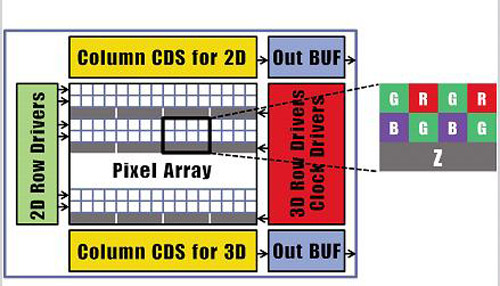
-----
Personal Comment:
Some additional information on BSI (Backside illumination)/FSI (Frontside Illumination):
Friday, March 23. 2012
Android and Linux re-merge into one operating system
Via ZDNet
-----
Android has always been Linux, but for years the Android project went its own way and its code wasn’t merged back into the main Linux tree. Now, much sooner than Linus Torvalds, Linux’s founder and lead developer, had expected, Android has officially merged back into Linux’s mainline.
The fork between Android and Linux all began in the fall of 2010, “Google engineer Patrick Brady stated that Android is not Linux” That was never actually the case.Android has always been Linux at heart.
At the same time though Google did take Android in a direction that wasn’t compatible with the mainstream Linux kernel. As Greg Kroah-Hartman, the maintainer of the stable Linux kernel for the Linux Foundation and head of the Linux Driver Project, wrote in Android and the Linux kernel community, “The Android kernel code is more than just the few weird drivers that were in the drivers/staging/androidsubdirectory in the kernel. In order to get a working Android system, you need the new lock type they have created, as well as hooks in the core system for their security model. In order to write a driver for hardware to work on Android, you need to properly integrate into this new lock, as well as sometimes the bizarre security model. Oh, and then there’s the totally-different framebuffer driver infrastructure as well.” That flew like a lead balloon in Android circles.
This disagreement sprang from several sources. One was that Google’s Android developers had adopted their own way to address power issues with WakeLocks. The other cause, as Google open source engineering manager Chris DiBona pointed out, was that Android’s programmers were so busy working on Android device specifics that they had done a poor job of co-coordinating with the Linux kernel developers.
The upshot was that developer circles have had many heated words over what’s the right way of handling Android specific code in Linux. The upshot of the dispute was that Torvalds dropped the Android drivers from the main Linux kernel in late 2009.
Despite these disagreements, there was never any danger as one claim had it in March 2011, that Android was somehow in danger of being sued by Linux because of Gnu General Public License, version 2 (GPLv2) violations. As Linus himself said at the time, claims that the Android violated the GPL were “totally bogus. We’ve always made it very clear that the kernel system call interfaces do not in any way result in a derived work as per the GPL, and the kernel details are exported through the kernel headers to all the normal glibc interfaces too.”
Over the last few months though, as Torvalds explained last fall, that while “there’s still a lot of merger to be done … eventually Android and Linux would come back to a common kernel, but it will probably not be for four to five years.” Kroah-Hartman added at the time that one problem is that “Google’s Android team is very small and over-subscribed to so they’re resource restrained It would be cheaper in the long run for them to work with us.” Torvalds then added that “We’re just going different directions for a while, but in the long run the sides will come together so I’m not worried.”
In the event the re-merger of the two went much faster than expected. At the 2011 Kernel Summit in Prague in late October, the Linux kernel developers “agreed that the bulk of theAndroid kernel code should probably be merged into the mainline.” To help this process along, theAndroid Mainlining Project was formed.
Things continued to go along much faster then anyone had foreseen. By December, Kroah-Hartman could write, “by the 3.3 kernel release, the majority of the Android code will be merged, but more work is still left to do to better integrate the kernel and userspace portions in ways that are more palatable to the rest of the kernel community. That will take longer, but I don’t foresee any major issues involved.” He was right.
Today, you can compile the Android code in Linux 3.3 and it will boot. Still, as Kroah-Hartman warned, WakeLocks, still aren’t in the main kernel, but even that’s getting worked on. For all essential purposes, Android and Linux are back together again.
Related Stories:
Linus Torvalds on Android, the Linux fork
It’s time Google starts paying for Android updates
Google open source guru says Android code will be in Linux kernel in time
Wednesday, March 21. 2012
World’s First Flying File-Sharing Drones in Action
Via TorrentFreak
-----
A few days ago The Pirate Bay announced that in future parts of its site could be hosted on GPS controlled drones. To many this may have sounded like a joke, but in fact these pirate drones already exist. Project “Electronic Countermeasures” has built a swarm of five fully operational drones which prove that an “aerial Napster” or an “airborne Pirate Bay” is not as futuristic as it sounds.
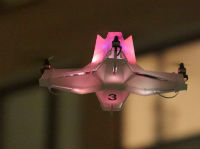 In an ever-continuing effort to thwart censorship, The Pirate Bay plans to turn flying drones into mobile hosting locations.
In an ever-continuing effort to thwart censorship, The Pirate Bay plans to turn flying drones into mobile hosting locations.
“Everyone knows WHAT TPB is. Now they’re going to have to think about WHERE TPB is,” The Pirate Bay team told TorrentFreak last Sunday, announcing their drone project.
Liam Young, co-founder of Tomorrow’s Thoughts Today, was amazed to read the announcement, not so much because of the technology, because his group has already built a swarm of file-sharing drones.
“I thought hold on, we are already doing that,” Young told TorrentFreak.
Their starting point for project “Electronic Countermeasures” was to create something akin to an ‘aerial Napster’ or ‘airborne Pirate Bay’, but it became much more than that.
“Part nomadic infrastructure and part robotic swarm, we have rebuilt and programmed the drones to broadcast their own local Wi-Fi network as a form of aerial Napster. They swarm into formation, broadcasting their pirate network, and then disperse, escaping detection, only to reform elsewhere,” says the group describing their creation.
File-Sharing Drone in Action (photo by Claus Langer)
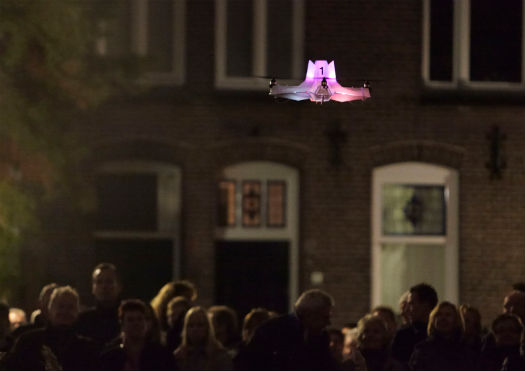
In short the system allows the public to share data with the help of flying drones. Much like the Pirate Box, but one that flies autonomously over the city.
“The public can upload files, photos and share data with one another as the drones float above the significant public spaces of the city. The swarm becomes a pirate broadcast network, a mobile infrastructure that passers-by can interact with,” the creators explain.
One major difference compared to more traditional file-sharing hubs is that it requires a hefty investment. Each of the drones costs 1500 euros to build. Not a big surprise, considering the hardware that’s needed to keep these pirate hubs in the air.
“Each one is powered by 2x 2200mAh LiPo batteries. The lift is provided by 4x Roxxy Brushless Motors that run off a GPS flight control board. Also on deck are altitude sensors and gyros that keep the flight stable. They all talk to a master control system through XBee wireless modules,” Young told TorrentFreak.
“These all sit on a 10mm x 10mm aluminum frame and are wrapped in a vacuum formed aerodynamic cowling. The network is broadcast using various different hardware setups ranging from Linux gumstick modules, wireless routers and USB sticks for file storage.”
For Young and his crew this is just the beginning. With proper financial support they hope to build more drones and increase the range they can cover.
“We are planning on scaling up the system by increasing broadcast range and building more drones for the flock. We are also building in other systems like autonomous battery change bases. We are looking for funding and backers to assist us in scaling up the system,” he told us.
Those who see the drones in action (video below) will notice that they’re not just practical. The creative and artistic background of the group shines through, with the choreography performed by the drones perhaps even more stunning than the sharing component.
“When the audience interacts with the drones they glow with vibrant colors, they break formation, they are called over and their flight pattern becomes more dramatic and expressive,” the group explains.
Besides the artistic value, the drones can also have other use cases than being a “pirate hub.” For example, they can serve as peer-to-peer communications support for protesters and activists in regions where Internet access is censored.
Either way, whether it’s Hollywood or a dictator, there will always be groups that have a reason to shoot the machines down. But let’s be honest, who would dare to destroy such a beautiful piece of art?
Electronic Countermeasures @ GLOW Festival NL 2011 from liam young on Vimeo.
Quicksearch
Popular Entries
- The great Ars Android interface shootout (130675)
- Norton cyber crime study offers striking revenue loss statistics (100910)
- MeCam $49 flying camera concept follows you around, streams video to your phone (99682)
- Norton cyber crime study offers striking revenue loss statistics (57139)
- The PC inside your phone: A guide to the system-on-a-chip (56969)

